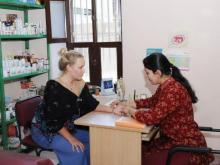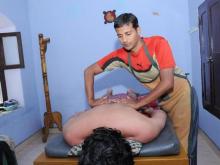Ayurveda
 The Science of Ayurveda and Panchakarma
The Science of Ayurveda and Panchakarma
What is Ayurveda?
The word “Ayurveda” comes from two Sanskrit words: Ayur meaning life and Veda meaning knowledge or science. Ayurveda is an approach to living in harmony with the universe in order to achieve optimum health. Developed around 1500 BC, this ancient science is built on solid theoretical and experiential foundations which provide a profound understanding of the physical and biological laws that govern human physiology.
The Four Aspects of Life
Ayurveda defines life as the intelligent coordination of four aspects: atma (soul), manas (the mind), indriyas (the senses), and sharira (the body). Each aspect has specific functions which contribute to the wholeness we experience as life, and Ayurveda focuses on maintaining a balanced, integrated relationship among them.
The Five Great Elements
 Ayurveda is built on an understanding of nature through an ancient theory which holds that everything in physical creation is comprised of five fundamental building blocks of nature called elements, each with specific qualities and unique characteristics. These elements, in sequential order of their density, are:
Ayurveda is built on an understanding of nature through an ancient theory which holds that everything in physical creation is comprised of five fundamental building blocks of nature called elements, each with specific qualities and unique characteristics. These elements, in sequential order of their density, are:
(Space)—-> (Air)—–> (Fire)—–> (Water)—–> (Earth)
The Doshas
Ayurveda teaches that when undifferentiated consciousness manifests into living forms, these five elements organize themselves into three essential principles or Doshas:
- Vata – the principle of movement
- Pitta – the principle of transformation or metabolism
- Kapha – the principle of cohesion or structure
These Doshas are responsible for coordinating all the structures and substances of the body, and underlie every aspect of Ayurvedic theory and practice, including all approaches to health and healing.
Understanding the nature of each of the five elements and their organizing principles or Doshas gives insight into the dynamics that drive all bodily processes.
The Ayurvedic View of Human Anatomy
The Seven Dhatus
The Dhatus are substances and structures that are retained by the body and always rejuvenated or replenished. There are seven Dhatus that form the structures and substances of the body.
- Rasa – Nutritional fluid; plasma
- Rakta – Blood; life force
- Mamsa – Muscles; cove bone
- Meda – Adipose tissue; lubrication
- Asthi – Bones; help in standing and walking
- Majji – Bone marrow; nerve tissue nourishment
- Shukra – Semen/ovaries; reproduction
The Three Malas
The Malas are those substances which the body normally expels as byproducts as it creates and maintains the Dhatus.
- Purisha (feces) – Eliminates toxins in solid form through the colon.
- Mutra (urine) – Eliminates toxins in solid form through the kidney.
- Sweda (sweat) – Eliminates toxins through the pores of the skin.
These substances are expelled because they are neither necessary nor beneficial. If the Malas are not expelled from the body at the appropriate time and in the proper quantity, their accumulation causes an imbalance that damages the functioning of the body’s structures and substance.
The Relationship between Doshas, Dhatus, and Malas
The Doshas act together as a carrier vehicle to bring food, oxygen, and water from the GI tract to the superficial and deep tissues of the body which make up the Dhatus. Because the Doshas can move freely between the Dhatus and the GI tract, they also transport metabolic by-products and toxins, or Malas, from the Dhatus into the GI tract for elimination. As intermediaries between Dhatus and Malas, the Doshas influence their condition and status in the body, combining with Dhatus and Malas without being changed or harmed. The importance of the Doshas in healing and rejuvenating the body is enormous.
- Doshas can move anywhere in the body.
- Doshas can discriminates between what the body should retain and what it should eliminate, and act accordingly.
- Each Dosha is most efficient in eliminating impurities that accumulate in its own zone of functioning.
- The Doshas’ twice daily migration is the best time for the movement of waste products from the body’s deeper structures to hollow structures, and the movement of nutritional products from the GI tract to the deep tissues.
The Individual Constitution or Prakrti
Prakrti
While everyone has all three Doshas in their body, the amounts differ from person to person. The differing proportions of Doshas give rise to the vast diversity in size, shape, complexion, energy levels and health of people, as well as the great variety in intelligence, emotional responses, and adaptability.
Each person’s unique Doshic constitution is known as Prakrti, or nature. The diversity we see in human beings is due to this Prakrti. Prakrti, or Doshic balance, provides a comprehensive understanding of the being in relation to the world. It includes physical structure, complexion, hair color, digestive capacity, appetite and stamina. It describes mental activity, general personality, and emotional reactions. Prakrti defines one’s truest nature; the most optimal way of being in life.
A person’s Prakrti is a blend of their parent’s Doshic constitution at the time of conception, and is determined by the balance of Doshas at the time of birth. When life is lived in accord with one’s constitution, the individual nature is perfectly attuned to that of Mother Nature and the result is ideal health. One finds life’s purpose and achieves maximum happiness with minimal effort.
Imbalance in the Constitution or Vikruti
Doshic structure often becomes imbalanced by excessive functioning of one’s strongest Dosha, disturbing the natural, optimum relationship of the Doshas. This is called Vikruti which means out of nature. When the natural balance is disturbed because of the excess of one or more Doshas out of alignment with an individual’s Prakrti, “Ama” begins to form which damages the Dhatus and impairs the elimination of the Malas.
It is often difficult to determine an individual’s Prakrti because it may be hidden underneath the imbalances caused by years of poor eating and behavioral choices. However, it isn’t necessary to know the exact Prakrti because it is the Vikruti that needs to be treated. When the Doshic aggravation or imbalance is corrected, the Prakrti naturally emerges.
No one has perfect balance of all three Doshas; one’s personal Dosha depends on the relative strengths of each Dosha. Most often when the Doshic dominance is determined it is actually the individual’s Vikruti that is determined because it overshadows Prakrti. Additionally, the most dominant Dosha is not always responsible for Vikruti. For example, Vata can often be the source of imbalance even when it is not the dominant Dosha. Thus, Ayurveda places great emphasis on the alleviation of aggravated Vata.
Ayurveda uses two modalities in the treatment of disease: Shamana therapy and Shodhana therapy. Shamana therapy focuses only on alleviating the symptoms, and thus cannot ever cure a problem. Shodhana therapy is a procedure for eradicating disease at is source by ridding the body of Ama and Malas to restore balance to the Doshas.
Panchakarma is a Shodhana therapy. It is also called purification therapy because it reverses the disease mechanism that carries toxic waste products from the digestive tract into the tissues of the body. Panchakarma draws Ama out of the body’s tissue, returns it to the digestive tract, and expel its.
Panchakarma is a three-step process:
Pre-Panchakarma: This set of procedures, called Purvakarma, helps loosen Ama and move it out of tissue into the GI tract. The most important procedures used to prepare the system for cleansing are:
- Snehana, a process of oleating the body with different oil massages external oleation to induce tissues to release accumulated toxins by stimulating secretions in the dhatus.
- Internal oleation with ghee and herbs which attach to the Ama released and transport it to the GI tract.
- Swedna, a type of steam bath which decreases the cold and stiffness of Vata and Kapha and counters the slow, heavy, and sticky attributes of Ama. Ama then is therefore liquefied and easily transported. In addition, swedna produces tissue expansion which facilitates Ama’s release.
- Lifestyle modifications include isolation, reduction of sensory inputs, meditation, pranayama, and gentle yoga therapy, as well as a diet of easily digestible foods like kichari.
Panchakarma: Procedures used to remove bound Ama from the GI tract.
- Naysa, nasal cleansing and therapy, removes Ama from the Kapha Dosha zone or diseases
- Virechna (purgation) removes Ama from Pitta zones or diseases.
- Basti (medicated enemas) removes Ama from Vata Dosha zones or diseases.
Post Panchakarma: Procedures that follow-up on the main treatments of Panchakarma and assist in the rebuilding process, known as Paschatkarma, to ensure the reestablishment of healthy metabolic function and immunity.
- Samsarajana Karma, involves rebuilding the agni, or digestive fire, for proper digestion via a graduated diet for a specified period. Dinacharya, or a prescribed daily routine. Rasayanas, or rejuvenative therapy to rebuild the essence of Dhatus using refined and concentrated herbal and mineral formulas that support healthy body tissue and structures. Rasayanas are not effective unless Panchakarma therapy has finished opening up the dhatus to the beneficial effects of herbs
It may take up to three months to realize the full potential of the Panchakarma procedures. It is therefore recommended to continue Rasayanas at least for three months after the Panchakarma.
